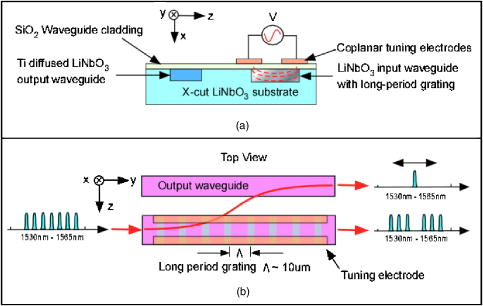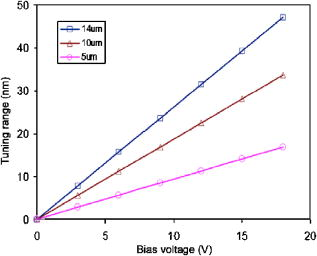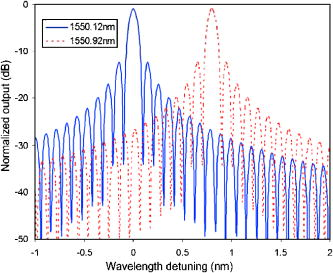|
|
|
Dense wavelength division multiplexing (WDM) is becoming a leading technology in fiber-optic networks.1, 2, 3 Dynamic WDM technologies with reconfigurable channels, bandwidth, and network topologies are expected to support aggregate bandwidth and low latency requirements of both civilian and military applications such as Internet access, high-quality videoconferencing, and information acquiring and sharing in aerospace. Tunable optical filters are among the key devices in realizing the dynamic WDM networks due to their capability of providing various dynamic functions such as wavelength tunable receivers, optical channel/wavelength selections, and reconfigurations.3, 4 To achieve these functionalities, general requirements for tunable optical filters include a large wavelength tuning range covering all WDM channels, low insertion loss, narrow passband, low polarization-dependent loss (PDL), and low channel cross talk. Existing electro-optic (EO) tunable optical filter technologies include fiber Fabry-Perot (F-P) interferometers, arrayed waveguide gratings (AWG), liquid crystal F-P interferometers, Mach-Zehnder interferometers, acousto-optic filters, and fiber Bragg gratings (FBG).4, 5, 6, 7, 8, 9 While these optical filters have been employed in various optical networks, however, the major limitation is the small wavelength tuning range of a few nm, mainly due to the small EO coefficients of existing materials, such as and EO polymers.3, 10, 11 The small wavelength tuning range makes these devices unsuitable for broadband channel selections and reconfigurations across the whole WDM wavelength range (for example, C-band, to ). In this paper, we present a new EO filter structure based on a long-period-grating-assisted asymmetric waveguide coupling mechanism. An ultra-large wavelength tuning range exceeding in the C-band ( to ) and a narrow passband of can be achieved at a low driving voltage with a low channel cross talk of . The cross section and top views of the EO tunable filter are shown in Figs. 1a and 1b, respectively. The EO tunable filter consists of an input waveguide, an output waveguide, and a pair of coplanar EO tuning electrodes on top of the input waveguide. The input waveguide and the electrodes are separated by an cladding layer. The waveguides are Ti-diffused waveguides on an X-cut substrate. The input and output waveguides are asymmetric so that the coupling of optical signals between the two waveguides are phase-mismatched. The input waveguide has a long-period grating to generate an addition vector to provide phase-matched coupling for a certain wavelength. The phase-matching condition for optical coupling can be written as12, 13: where is the specific wavelength that meets the phase-match condition, is the period of the grating, and and are the effective indices of the input and output waveguide, respectively. The grating period is designed to be , which is significantly larger than that of conventional quarter-wavelength Bragg gratings. From Eq. 1, the phase-matched wavelength can be expressed as:Fig. 1Schematic structure of the EO tunable filter based on long-period-grating-assisted asymmetric coupling: (a) cross section; (b) top view.  The tuning of phase-matched wavelength can thus be achieved by electro-optically changing the effective index of the input waveguide . As shown in Fig. 1a, the bias voltage would generate an electric field along the direction. The EO-induced refractive index tuning can therefore be written as: where is the EO coefficient of along the direction (as shown in Fig. 1). The wavelength tuning can thus be written as:where is the applied tuning voltage, and is the effective separation of the top electrodes. The wavelength tuning ranges as a function of applied bias voltage for different grating periods are shown in Fig. 2 with parameters and for at the wavelength of . As shown in Fig. 2, for the grating period , an ultra-large wavelength tuning range of over can be obtained at a low tuning voltage of . Such a large tuning range enhancement factor overcomes the low EO coefficient limit of the conventional EO materials and allows the EO tunable filter to cover the whole C-band.Fig. 2Wavelength tuning range of the EO tunable filter as a function driving voltage for different grating periods.  The phase mismatch for the wavelength away from the central wavelength can be written as12, 13: where is the wavelength detuning. The output power of the phase-mismatched coupling can be written as:where is the length of the asymmetric coupling, and and are the output powers for the phase-mismatched and phase-matched coupling, respectively. Figure 3 shows the passband profiles of two adjacent 0.8-nm-spaced WDM channels with parameters , , and . As illustrated in Fig. 3, the filter shows a narrow passband of . The first sidelobes are located from the main peak, with a sidelobe suppression ratio (SLSR) of . For the sidelobes that are from the main peak, a high SLSR of can be obtained. Since ITU-Grid WDM channels have 0.8-nm-wavelength spacing, a low cross talk of can be expected. Higher SLSR can be obtained by reducing the grating period , which would increase the tuning voltage accordingly. The total insertion of the device consists of the coupling loss ( from Fig. 3) and the waveguide loss, which typically ranges from to at the wavelength of .14 The total device insertion loss is therefore less than .In conclusion, we present an EO tunable filter structure based on long-period-grating-assisted asymmetric waveguide coupling. This type of EO tunable filter overcomes the low EO coefficient limitation of convention materials and offers a large wavelength tuning range exceeding at a low driving voltage . It is expected to enable fast wavelength selection, communication channel reconfiguration, and packet- or cell-level switching for highly dynamic WDM optical networks. ReferencesJ. P. Ryan,
“WDM North American development trends,”
IEEE Commun. Mag., 36
(2), 40
–44
(1998). https://doi.org/10.1109/35.648755 0148-9615 Google Scholar
T. Segawa,
S. Matsuo,
Y. Ohiso,
T. Ishii,
Y. Shibata, and
H. Suzuki,
“Fast tunable optical filter using cascaded Mach-Zehnder interferometers with apodized sampled gratings,”
IEEE Photonics Technol. Lett., 17 139
–141
(2005). https://doi.org/10.1109/LPT.2004.837473 1041-1135 Google Scholar
D. Sadot and
E. Boimovich,
“Tunable optical filters for WDM networks,”
IEEE Commun. Mag., 36
(12), 50
–55
(1998). https://doi.org/10.1109/35.735877 0148-9615 Google Scholar
Y. Hibino,
“Recent advances in high-density and large-scale AWG multi/demultiplexers with higher index-contrast silica-based PLCs,”
IEEE J. Sel. Top. Quantum Electron., 8 1090
–1101
(2002). https://doi.org/10.1109/JSTQE.2002.805965 1077-260X Google Scholar
J. Stone and
L. W. Stulz,
“Pigtailed high-finesse tunable Fabry-Perot interferometer with large, medium, and small free spectral ranges,”
Electron. Lett., 23 781
–783
(1987). https://doi.org/10.1049/el:19870554 0013-5194 Google Scholar
J. L. Jackel,
J. E. Baran,
A. d'Alessandro, and
D. A. Smith,
“A passband-flattened acousto-optic filter,”
IEEE Photonics Technol. Lett., 7 318
–320
(1995). https://doi.org/10.1109/68.372758 1041-1135 Google Scholar
J. Y. Liu and
K. M. Johnson,
“Analog smectic ferroelectric liquid crystal Fabry Perot optical tunable filter,”
IEEE Photonics Technol. Lett., 7 1309
–1311
(1995). https://doi.org/10.1109/68.473481 1041-1135 Google Scholar
E. L. Wooten,
R. L. Stone,
E. W. Miles,
E. M. Bradley,
“Rapidly tunable narrowband wavelength filter using unbalanced Mach-Zehnder interferometers,”
J. Lightwave Technol., 14 2530
–2536
(1996). https://doi.org/10.1109/50.548151 0733-8724 Google Scholar
A. Locco,
H. G. Limberger, and
R. P. Salathe,
“Bragg grating fast tunable filter,”
Electron. Lett., 33 2147
–2148
(1997). https://doi.org/10.1049/el:19971466 0013-5194 Google Scholar
M.-C. Oh,
H. Zhang,
C. Zhang,
H. Erlig,
Y. Chang,
B. Tsap,
D. Chang,
A. Szep,
W. H. Steier,
H. R. Fetterman, and
L. R. Dalton,
“Recent Advances in electrooptic polymer modulators incorporating highly nonlinear chromophore,”
IEEE J. Sel. Top. Quantum Electron., 7 826
–835
(2001). https://doi.org/10.1109/2944.979344 1077-260X Google Scholar
W. H. Steier and
H.-C. Song,
“Advances in polymer waveguide devices,”
748
–749
(2003). Google Scholar
A. Yariv,
“Coupled-mode theory for guided-wave optics,”
IEEE J. Quantum Electron., 9 919
–933
(1973). https://doi.org/10.1109/JQE.1973.1077767 0018-9197 Google Scholar
A. Yariv and
P. C. Yeh, Optical Waves in Crystals, Wiley, New York (1984). Google Scholar
K. Noguchi,
O. Mitomi,
H. Miyazawa, and
S. Seki,
“A broadband optical modulator with a ridge structure,”
J. Lightwave Technol., 13 1164
–1168
(1995). https://doi.org/10.1109/50.390234 0733-8724 Google Scholar
|


